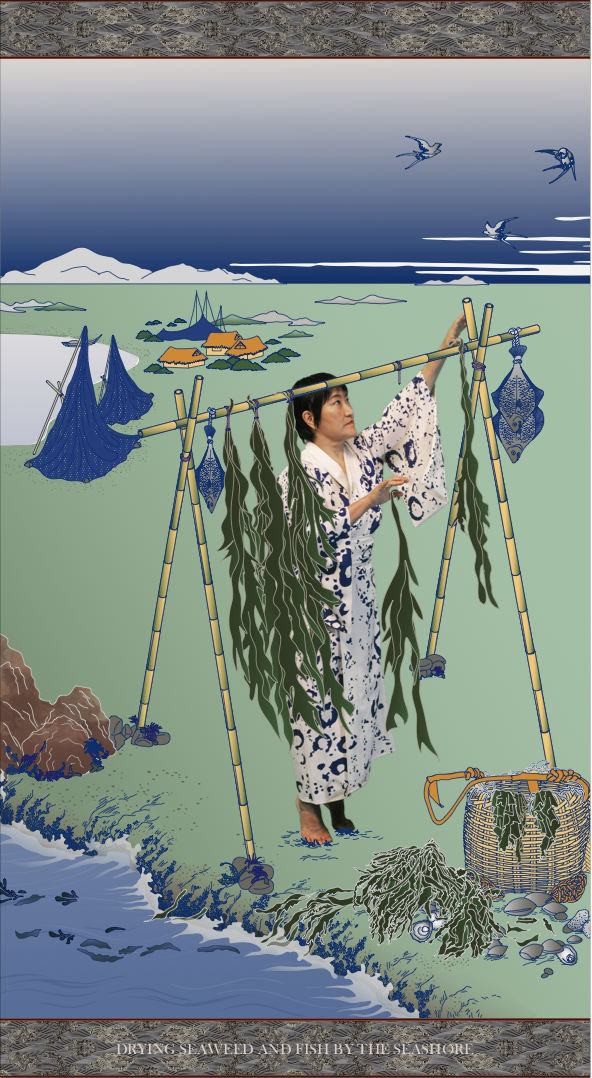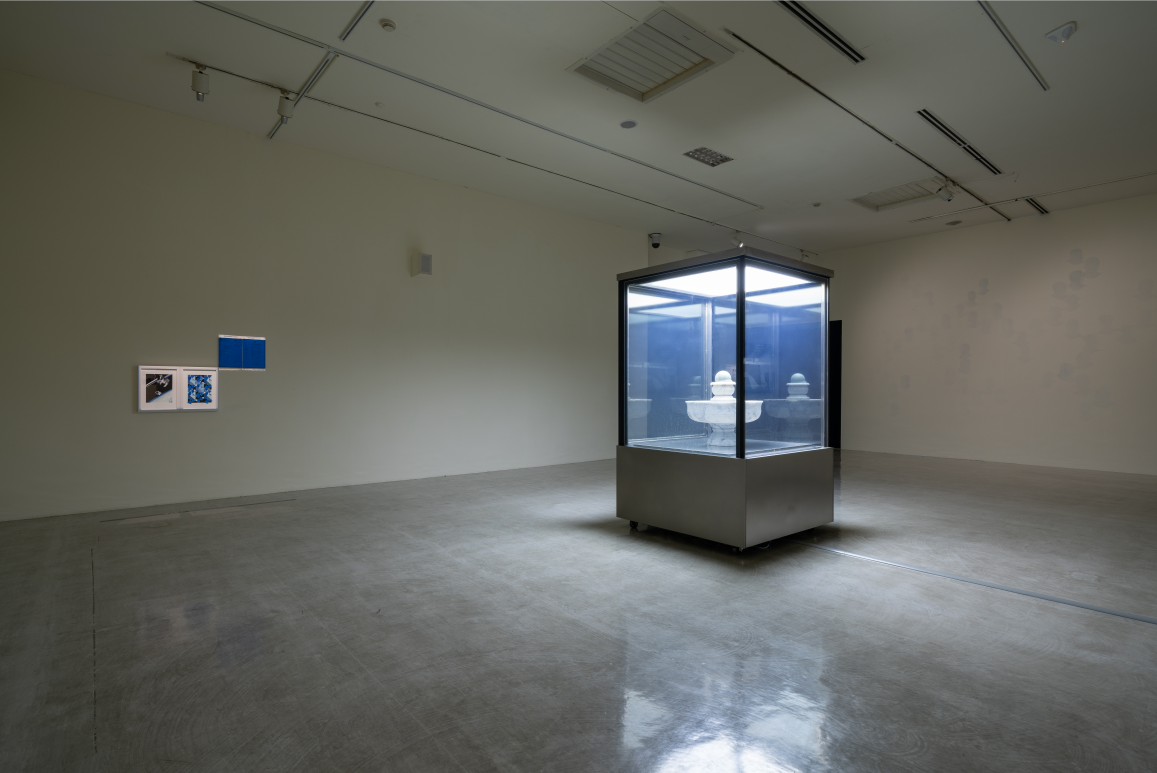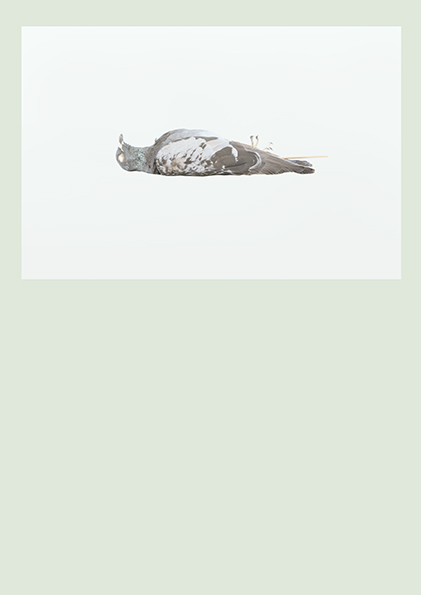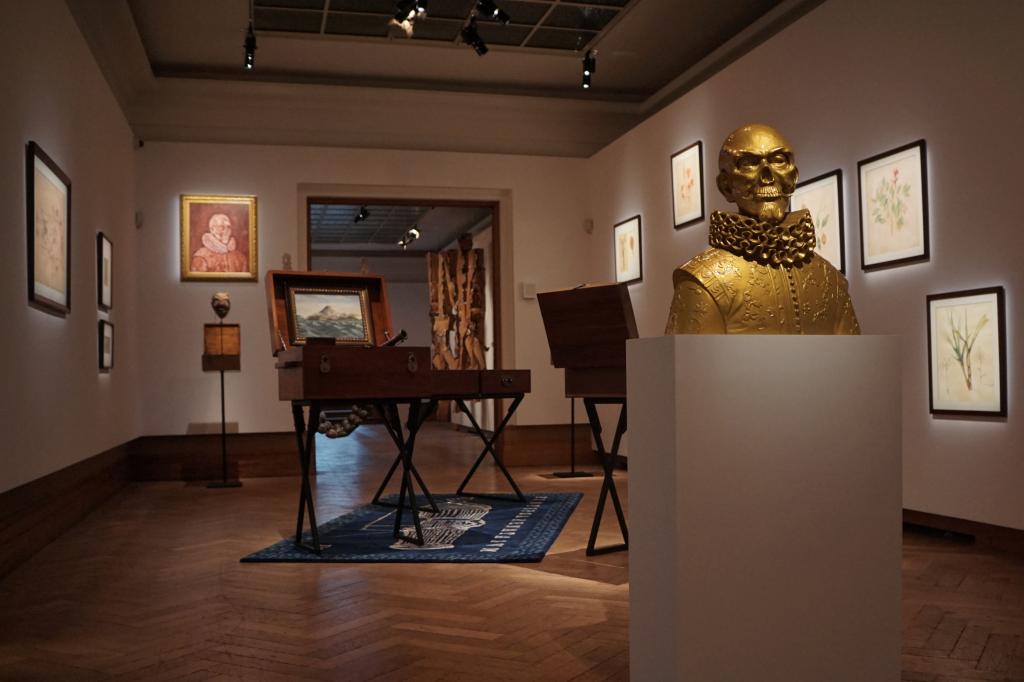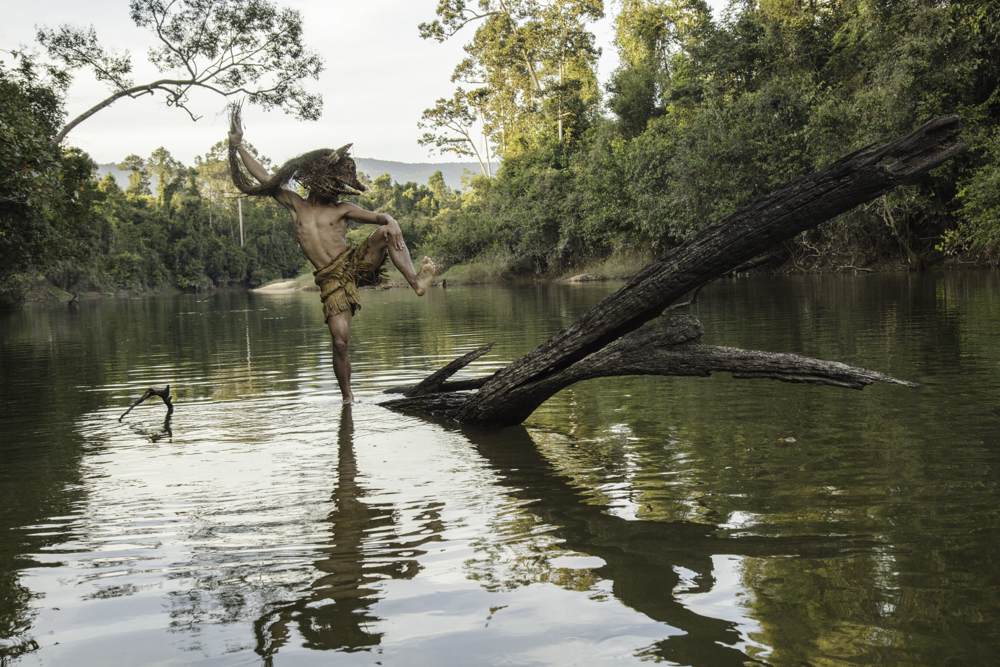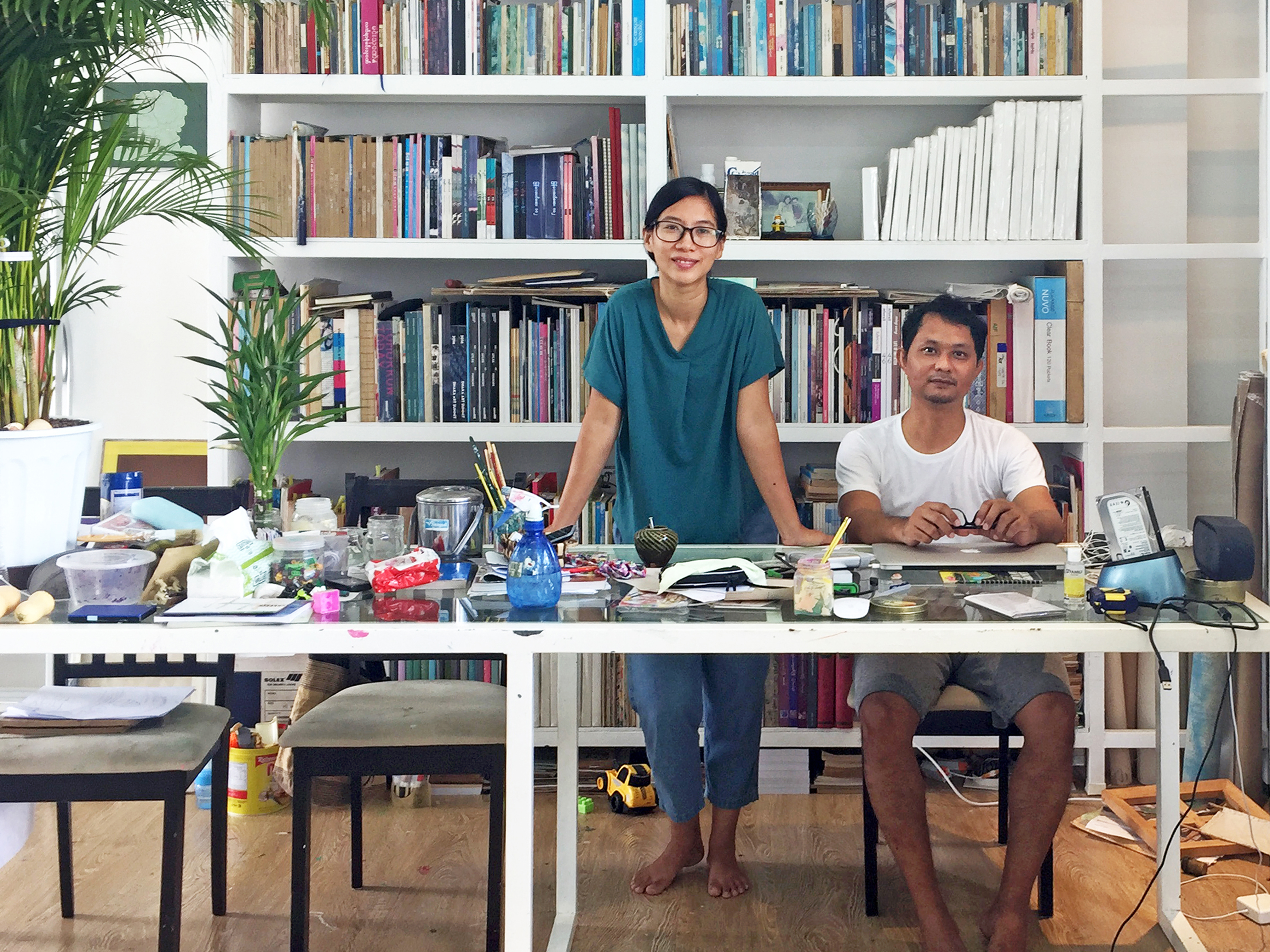
246247596248914102516 … And then there were none (2017), installation view of the sculpture. All images courtesy of the artist
Arin Rungjang’s 246247596248914102516 … And then there were none (2017) was created for Documenta14. It consists of two different and independent parts, one which was exhibited in Kassel, Germany and one which was exhibited in Athens in Greece. This article focuses on the installation displayed in Kassel. It revolves around the Democracy Monument erected in Bangkok to commemorate the 1932 revolution that overthrew the absolute monarchy, and around the figure of Phrasat Chuthin, the Thai ambassador who, allegedly, was the last visitor of Hitler in his Berlin bunker before the suicide of the German Führer. Rungjang draws also from his personal family story to propose a poetic yet challenging vision of Thailand’s recent history that questions historiography and the reading of national symbols.
Born in Bangkok in 1975, Arin Rungjang studied at the Silpakorn University and spent one year in Paris, France at the École Nationale Supérieure des Beaux Arts. He represented Thailand at the 55th Venice Biennale with Golden Teardrop (2013) a site-specific installation based of the artist’s research on the transnational history of sugar. Rungjang’s multimedia installations often stage a dialogue between videos and sculptural works and arise from the artist’s research on micro or personal narratives that cross and intertwine with grand narratives. The point of departure of 246247596248914102516 … And then there were none is the collusion of two different stories: on the one hand the death of the artist’s father and the involvement of his grandfather in the 1932 revolution, and on the other hand a documentary about the last days of Hitler and his meeting with the Thai ambassador. The installation features a real-size replica of a panel from the Democracy Monument, the painted portraits of Phrasat Chuthin and his wife as well as some replicas of archival documents and a 46-minute video that altogether point to the ambiguities of Thai democracy and to the prevailing power of the military. For Rungjang, research is a means to explore and highlight some neglected parts of history and hidden layers of knowledge, yet beyond politics he first and foremost conceives his work as a poetic and aesthetic representation of reality.[1]
Contextual framework and artists’ drive
A personal drive
“Since I can remember, I have listened to my mother’s account of my father’s misfortune countless times.” The video begins with the narrator-artist’s voice narrating the story of his family, and in particular how his father, who worked as a sailor in Germany, was beaten to death for no apparent reasons by a group of Neo-Nazis in Berlin while Rungjang was just a child.[2] Since he was too young to understand, he remembers this event as a dream. However, for a long time, he has been searching for a way to reflect on this personal story from an artistic perspective. Rungjang is especially interested in how “normal people” like his family members can be impacted by master narratives, even though they do not know about them. In particular, with the invitation to participate in Documenta14, he pondered his relationship with Germany where the institution originates. When watching a documentary about the Second World War (WWII) and Adolf Hitler’s chancellery, he found the link he was looking for.[3] A close-up shows the guestbook of Hitler’s Berlin bunker, where he was hiding at the end of the war, and the last name on the list happens to be a Thai name. Rungjang conducted research to identify this last visitor and found out it was the Thai ambassador to Germany, Prasat Chutin or Phra Prasatphitthayayut, who is little known in Thailand and who was an admirer of Hitler. After the Japanese occupation of the country, Thailand signed an alliance treaty with Japan and the country therefore joined the Axis powers. According to the artist, this collaboration is not taught at school and seldom addressed by the media or by any Thai cultural output. Besides, Rungjang discovered that Prasat Chutin had taken part in the 1932 revolution that led to the end of Thai absolute monarchy and officially marks the birth of democracy in Thailand. The artist’s own great grandfather opposed this rebellion and fought with the military to stop a movement he thought illegitimate. His engagement entailed the destruction of his family. Hence, interconnected threads arose from Rungjang findings as if fragmented pieces from a jigsaw puzzle found their right place: Thai’s embarrassing collaboration with the Nazis and the artist’s father being beaten by Nazis’ offspring whose ideology perdures to this day, and the founding of Thai democracy linked to Nazism, a relation that is far from being self-evident. Rungjang aims at pointing to these contradictions and complexities in order to invite the viewer to think anew about Thai history, its system of beliefs and symbols of power.
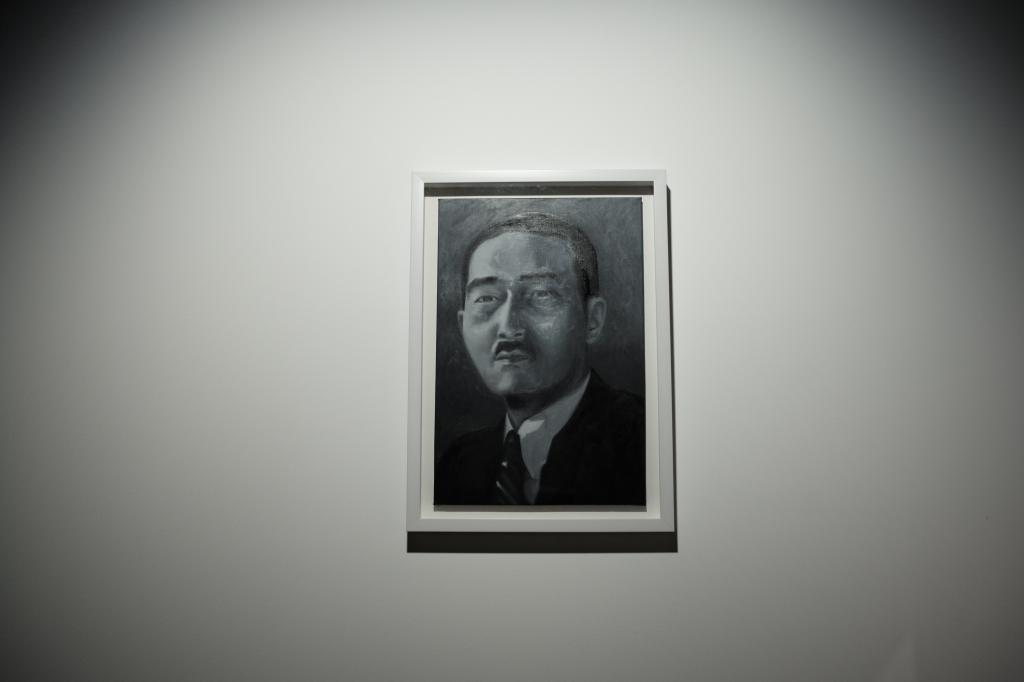
Portrait of Prasat Chutin, painting. 246247596248914102516 … And then there were none (2017)
Building Thai democracy
On 24 June 1932 Khana Ratsadon or the “People's Party” overthrew Thailand’s absolute monarchy and King Prajadhipok's government to install a constitutional monarchy. The name Siam was changed to Thailand. The new leaders’ inaugural discourse took place in the Royal Plaza in Bangkok where a memorial plaque was first laid in 1936 and where, eventually, the Democracy Monument was then built in 1939 to commemorate the place where the Thai political system transformed itself radically. The monument is constituted by 4 huge sculptures (the wings) representing the four branches of the Thai armed forces—army, navy, air force and police—which carried out the 1932 coup, and a centrepiece in the middle. The sides of the wing-sculptures feature sculptural panels that were executed by the Italian sculptor Corrado Ferroci who was originally commissioned by King Rama VI to teach Western sculpture at the Fine Arts Department of the Ministry of Palace Affairs. In 1943, Ferroci established the first art school of the country, the Silpakorn university, where Rungjang studied. Known by his Thai name Silpa Bhirasri, he is remembered as the father of Thai modern art but his role within the People's Party, and the public sculptures he designed, tend to be omitted in his biographies.[4] Ferroci came from Florence where he taught at the Royal Art Academy and the modern style he brought from Italy was imbued with a heroic neoclassicism promoted by Mussolini, re-appropriated by Thailand’s newly-formed governments in their search to strengthen Thailand’s new national unity.[5] For Rungjang, this influence embeds the Democracy Monument into fascism and works as a reminder of Thai’s narrow collaboration with the Nazis, later exemplified by the figure of the Thai ambassador in Berlin. For his sculpture replica, the artist chose a panel entitled "Soldiers Fighting for Democracy," which shows a heroic and united armed force fighting for "democracy." In fact, none of the panels represents the people despite the People's Party’s promise to rule “by the people.” The group was composed of civil officers and military who soon took the lead and, in 1939 when the Democracy Monument was finally inaugurated, Thai was ruled by a military dictatorship under a martial law. Hence, the 1932 coup did not bring democracy to the country and mainly resulted in two changes that have defined Thai politics for the following decades: “first, political power moved from monarchy to bureaucracy (the new elite), and second, military bureaucrats became more powerful than civilian bureaucrats.”[6] As such, it seems ironical that the Democracy Monument has continued to embody democracy and has constantly served as a rallying point for all the pro-democracy protests that arose in the country since WWII.
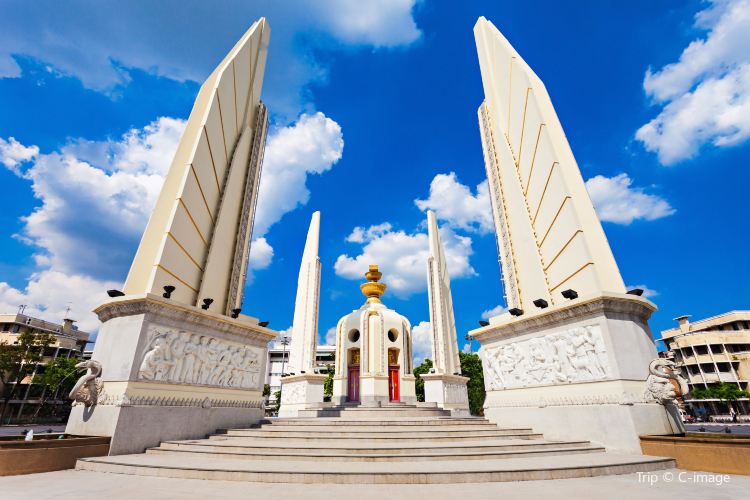
Democracy Monument in Bangkok (image from Internet)
Scholar Ka Wong studied Thai public monuments and demonstrated how they have been used to legitimize the ruling power and to activate people’s imagination about their national identity.[7] The real history of the 1932 revolution and of the Democracy Monument is hardly known to the Thai people. There is a rumour according to which the inaugural plaque was removed between 1958 and 1963, then replaced again by a new one in 2017,[8] and art historian Chotpradit notes that “just like the 1932 Revolution, the People’s Party’s Plaque has no place in the royalist state since it signifies interruption in the chronological flow of Thai royalist history.”[9] In particular, it stands against the royalist views according to which Prajadhipok (King Rama VII), the first constitutional monarch, is the father of Thai democracy. In the 1980s, some of the monuments edified under the People's Party were demolished, reflecting a shift in power and the return of the royalist ideology. More generally, “the cultural legacy of the revolution was buried in the grave of historical oblivion as it has been ignored by Thai art historians.”[10] Recently, the People’s Party legacy and the debate over the origin of Thai democracy have been revived, especially since the 2006 military coup through the United Front for Democracy against Dictatorship known as the Red Shirt movement which challenges the Thai monarchy.[11] In general, scholars have emphasized the turmoil of Thai politics with the country having experienced “over thirty military coups or coup attempts since 1932 and 25 years of intermittent, elected civilian rule.”[12] It is against such a backdrop of a recursive history and alternance between oblivion and re-appropriations of the political symbols that Rungjang decided to revive this part of Thai history from his own and artistic perspective. Indirectly, the installation hints also at the aftermath of the 14 October 1973 uprising when 400,000 people marched against the military junta from Thammasat University to the Democracy monument. The movement temporarily led to the end of the military dictatorship yet, almost 3 years later in October 1976, the former dictator came back in power. The new protests were bloodily repressed in what is known as the Thammasat University massacre. This reference is far from being obvious in the work exhibited in Kassel, though, and is hidden in the installation’s title, a riddle which I will examine later.[13]
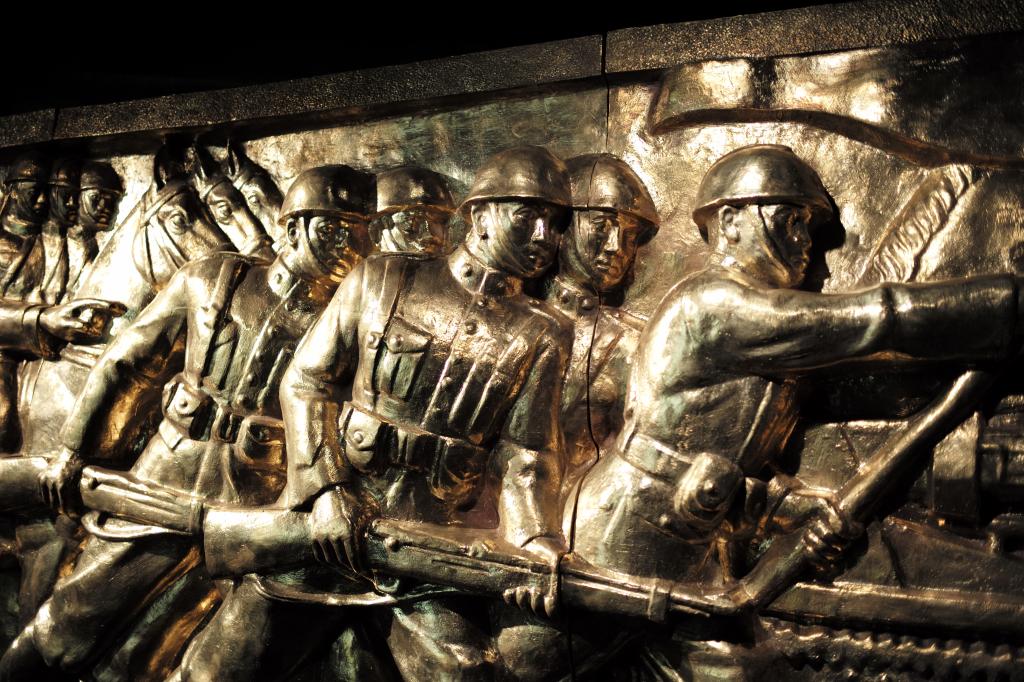
Detail of the artist’s sculpture. 246247596248914102516 … And then there were none (2017)
Collaborating with the Nazis
The General Phrasat Chuthin or Phra Prasasana Bhidyayudha appears as a mysterious figure in Thai history. There is little information to be found about him except that his name and photograph come up with those of other military officers from the People’s Party known as the Four Musketeers or the Four Tiger Soldiers. He studied military science in Germany where his classmates became Nazi members. When he returned to Thailand, he joined Khana Ratsadon and participated in the 1932 revolution. Probably because of his German connections, he was assigned ambassador of Thailand in Berlin in 1939. After the fall of the Reich, he was arrested by the Red Army and sent to a camp in Russia before returning back to Thailand in January 1946. He died a few years later.
Rungjang found his memoirs entitled 225 Days in a Russian Prison and based a large part of his work on this unpublished text that the ambassador wrote in honour of his wife when she died, as it used to be the tradition. In particular, Phrasat Chuthin relates his first meeting with Adolph Hitler and shares his impression of the Nazi leader: “I have never seen anyone who has been gentle to me like him in Germany. He is the real gentleman in my eyes.” He is probably the last person who saw Hitler alive, outside the Fuhrer’s personal relatives. In Hitler’s guestbook, the date of his visit is April 24, 1945 and Hitler killed himself on April 30, 1945, in his bunker.
In Thailand, hardly anybody knows about Phrasat Chuthin. His memoirs were finally published but as a fiction, so that the book could not trigger any political controversies.[14] He can paradoxically be perceived as a hero of the Thai revolution and as a friend of the Nazi party who embodies Thailand’s alliance with the Axis, a subject that remains taboo in the country. During the Japanese occupation of the country, and the Thai alliance with the Nazis, Thailand was under the reign of King Ananthamahidon (Rama VIII) who was born in Germany and who lived in Switzerland. He only returned to Thailand in December 1946 and was shot the same year in his room at the age of 20.[15] His death is also shrouded with mystery and the political blame about that chaotic period is often put on the People's Party and on its military Prime Minister Phibun who ruled from 1938 to 1944. The People's Party rule ended with a coup in 1947, endorsed by the new King Rama IX.[16] The monarchy and the military elites were thus back in power, claiming their paternity over democracy but leaving the rest of history within oblivion. According to the artist, no one in Thailand feels guilty about the country’s stance during WWII and the issue is never discussed. Unlike Germany, Thailand never apologized for its stance in the war.
The artist-researcher
The artist-historian
Rungjang has always been interested in history and most of his work delves into Thai history. In Mongkut (2015), for example, he investigated the history of the Chakri royal crown, whose exact replica was given by King Mongkut (Rama IV) in 1861 to French emperor Napoleon III in effort to save the autonomy of the Kingdom, surrounded by Western colonies. The original crown cannot be seen anymore and has been allegedly kept in the Royal Palace since the death of King Rama VIII in 1946. The artist collaborated with King Mongkut’s great, great, great granddaughter, specialized in craftsmanship, who created another replica of the crown.
Rungjang did not learn historical methodology, though, and believes his work is in fact not so much connected to the practice of an historian, since history, as a field, develops under certain rules and constructive approaches that he does not follow. The artist relates that when he exhibited Mongkut in Bangkok, a historian came to him to criticize the historical inaccuracy of his installation. Rungjang confesses he is also inspired by rumours and does not
claim to work like a historian. His approach of history is non-linear and includes personal stories. He feels more concerned with the artistic expression of his research findings and with how he can incorporate hidden or forgotten stories into his artistic practice and develop them from a visual and aesthetic perspective.
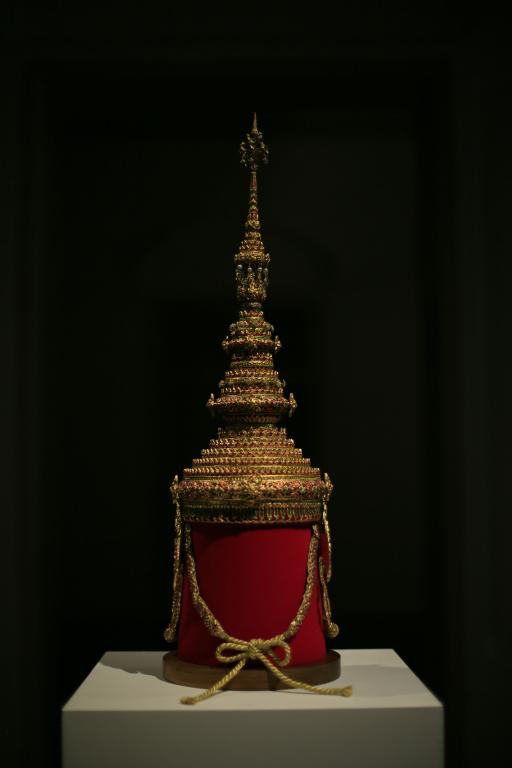
Arin Rungjiang, Mongkut (2015). Detail of the crown.
The connection he creates with historical narratives are also original and are not constructed according to any historical methodology: for 246247596248914102516 … And then there were none?, the artist emphasizes a correlation between the origins of Thai democracy and Thailand’s collaboration with the Nazis which is not self-evident and not supported by any evidence except through Phrasat Chuthin’s biography. This association rather arises from the artist’s personal interpretation of history and his desire to disrupt the usual narratives and to offer a fresh angle from which history can be perceived. Ultimately, with his artistic language and subjective stance, the installation questions and revives critically these parts of collective memories and the underlying context they overlay.
On the track of history
After watching the WWII documentary, Rungjang had only a Thai name written by hand in Hitler’s guestbook. He mainly conducted his research in libraries and through readings. He found the ambassador’s memoirs at the Thamasat university library in Bangkok. The portraits of Phrasat Chuthin and his wife feature also in the book and served as models for his paintings.
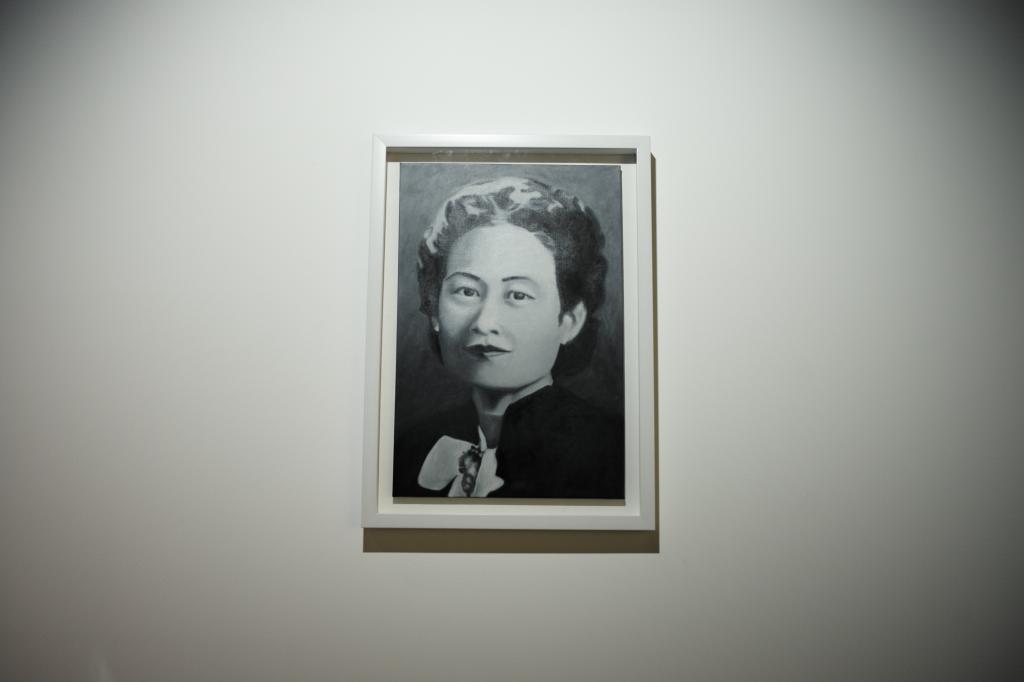
Portrait of the ambassador’s wife. Painting. 246247596248914102516 … And then there were none (2017)
Elena Sorokina, one of the co-curators of Documenta who is Russian, contacted the Russian military archives in order to retrieve Hitler’s guestbook that was taken when the Red Army soldiers entered Berlin in 1945. At first, Rungjang wished to display the original of the last page where Phrasat Chuthin’s signature can be seen along with the date of April 24, 1945, yet the Russian authorities did not accept to lend the book and sent a copy instead. There are debates about the last days of Hitler as well as conspiracy theories according to which Hitler escaped Germany and did not commit suicide, and Rungjang made research in order to find out if the Thai ambassador was really the last person who visited the Nazi leader. Phrasat Chuthin was supposed to leave Berlin but because his daughter was sick, he remained there despite the constant bombing of the city by Soviet artillery, so the narrative is plausible. Yet, again, Rungjang is less interested in finding out the truth than asking the right questions and weaving meaningful stories. During the opening of the exhibition, however, a relative of the ambassador came to him and thanked him for bringing back to life this part of history and making it public
In Berlin, the artist visited the site where Hitler’s bunker and his chancellery were located. They both were destroyed by the Red Army and the historical site is now a parking lot surrounded by public housing. There is only a billboard, written in German, that explains what happened on the site. The title is “Mythos und Geschichtszeugnis ‘Fuhrerbunker’” which means “Myth and historical testimonies of the Fuhrer’s bunker,” and this strangely opens the door to fictional interpretations of history. Rungjang decided to use this ambiguous place as his background for the dance parts of the video. The former chancellery area has also been transformed and many hotels have been built. The flat they filmed in the end of the video, which was part of Hitler’s residency, is now an Airbnb that they could rent for the whole shooting.
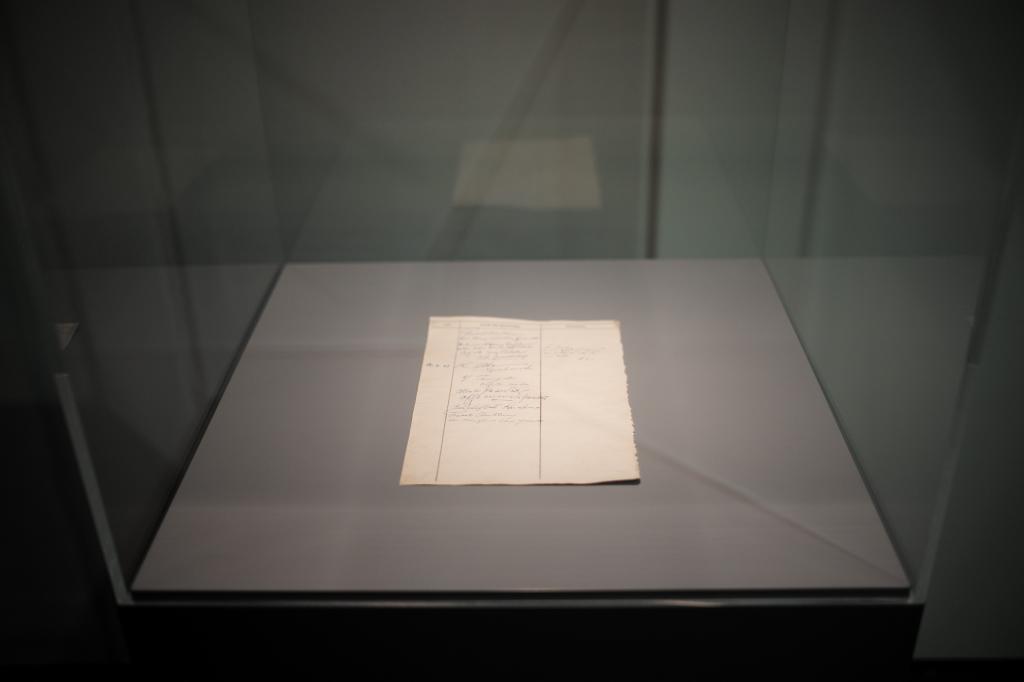
Hitler’s Guestbook. Detail from the exhibition. 246247596248914102516 … And then there were none (2017)
According to Rungjang, and despite the establishment of the National Archives of Thailand in 1952, doing research in Thailand remains difficult because many archival materials are still banned for the public. Censorship remains an important issue in the country, especially when it comes to address political issues that involve the royalty. The law of lese-majeste protects the kings and their family, and, for Thai historians, there might be compromises to find so that their research does not appear to question royal authority.[17] Aside from his readings, most of the artist’s research is thus done when he is traveling or online. In particular there are Thai discussing groups where pieces of information can be exchanged about the royal history, although the government requested the site to be closed.[18] This is notably why the artist does not display the ambassador’s memoirs as a piece of evidence: as with Hitler’s guestbook, the memoirs that he exhibits are a hand-made replica. Metaphorically, the artist suggests that Thai people have only access to representations of historical archives rather than originals from which to ground their collective memory.
Artistic transformations of the research findings
Replica: desacralizing symbols of power
The most impressive part of the installation, and the first one to catch the eye, is the real-size replica of one of the panels from the Democracy Monument cast in brass. From afar, and with the light effects of the gallery space, it almost makes one feel like the sculptures are made of gold. Soldiers are here shown preparing for a battle, receiving orders and checking their weapons under a tree. The original panel, designed by Ferroci, was made of concrete: a monument dedicated to the people, its material had to reflect its popular dimension. Rungjang diverts this initial intention and uses brass instead to refer to the material used for religious sculptures. As such, he brings an additional aura to the piece and emphasizes how much it has become sacralised, at least symbolically. Usually, people do not examine anymore the details of public monuments because they are used to see them and associate them with symbolic meaning. Taken out of its context, the panel can be re-evaluated in light of the present time.
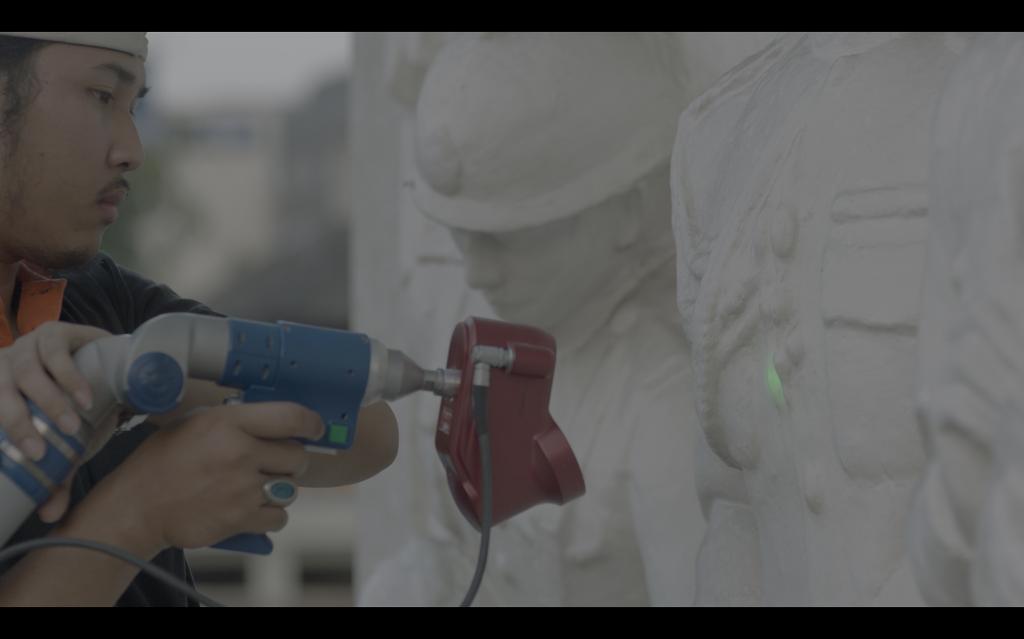
Workers scanning the Democracy Monument, still from the video. 246247596248914102516 … And then there were none (2017)
A large part of the panel’s creation processes is documented in the video, projected in the adjacent space. The artist used 3D scanning and up-to-date technologies to perfectly recast the sculptures: one can see the workers slowly scanning each centimetre of the panel, and it seems that they caress the stone and appropriate it. The camera operates back and forth, moving between the democracy monument and the screen of the computer where all the data is recorded and analysed. On the screen, the details of the sculptures appear, and in particular the head of the soldiers with their determined faces. The process resembles a medical scan and suggests that the artist is also delving into the inner and invisible parts of the bas-relief, hidden behind its smooth surface. Each spatial movement amounts in fact to a temporal move and a dive into the history of the panel. In the video, we see then how the moulds were casted in Nakornpathom where Buddha sculptures are also usually made and where the Kings’ statues of King Park in Bangkok were cast. Workers are applying layers and layers of plaster that could represent all the successive narratives that have been added to the monument since its creation, according to who was in power. The sculpture, at that stage, is an empty mould ready to be filled up with any constructed story. Once the burning liquid has been poured into it, and the bas-relief fired into large outdoor kilns, the workers break the mould and open it up as if it was a sarcophagus. They wear t-shirts with “Royal Thai Army” written on the back, and once again the role of the military in the making, transforming and preserving democracy is stressed.
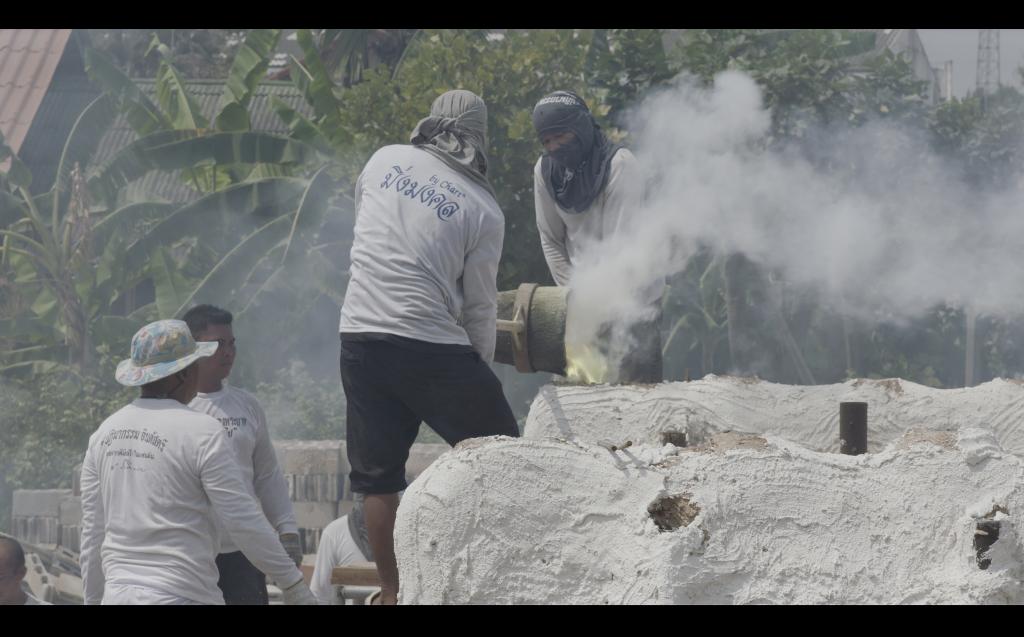
Workers moulding the sculpture, still from the video. 246247596248914102516 … And then there were none (2017)
When Rungjang’s father was still alive, working on oil tankers, he used to buy the artist some art souvenirs from his travels. Rungjang collected calendars featuring the Mona Lisa, miniatures of the Pieta by Michelangelo or poor reproductions of Caravaggio. These reproductions constituted his first introduction to Western art, and he valued them, even though they were pale and reproductible representations of masterpieces. Since then, as an artist, he has continuously questioned the language of representation and the poetics of objects. In particular, Rungjang often creates replicas as a way to challenge their symbolic and ideological value. For Mongkut, he reproduced the royal crown which stands for the royal authority and here he reproduces the panel that, for all Thai people, stands for democracy. These processes of work involve deconstructing the replicated objects and perceiving them as an assemblage of material parts that inevitably strip them from their constructed significance. As with Walter Benjamin’s description of reproduced ritual objects, both the crown and the panel become autonomous, freed from their symbolic and political value and detached from their historical charge. However, and almost paradoxically, Rungjang gives them back a new aura which is an artistic aura. This artistic transformation bestows them again a unique singularity, although desacralized and encapsulated in the present. The new golden-like monument can also be interpreted as a sparkly yet empty form that would stand for the illusion of democracy after Thai recursive history of military coups.
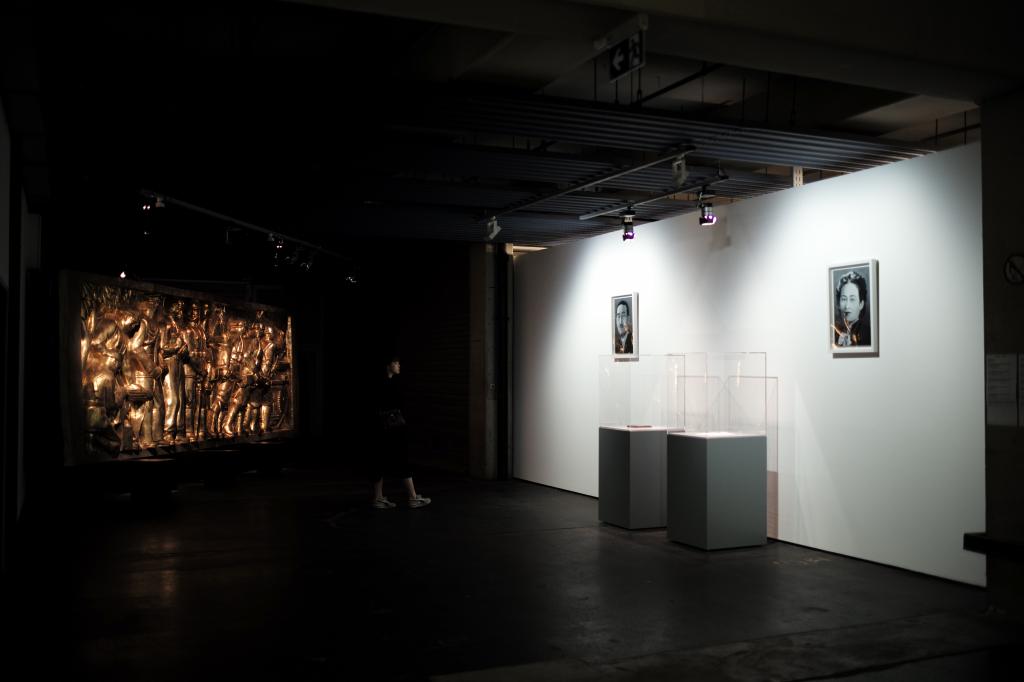
Exhibition’s view of Documenta. 246247596248914102516 … And then there were none (2017)
As mentioned earlier, the last page of Hitler’s guestbook and the ambassador’s memoirs are also hand-made replica of the originals, displayed in glass boxes. Through this choice, Rungjang emphasizes the impossibility to reach back to history and recalls that what can only be seized from the past are fragmented traces and copies or interpretations of those traces. The portraits of Phrasat Chuthin and his wife are representations of representations as well: they have been painted from a copy of their photographs reproduced in the ambassador’s memoirs. The oil paintings are painted in black and white with such a thin layer of paint that they can be taken for photographs. The faces of Phrasat Chuthin and his wife seem thus to be caught in a state of transition between the artistic world and the real world, made of archives and records, or between fiction and reality. Rungjang hung them almost facing the Democracy Monument panel, suggesting a dialogue between them: in his memoirs, the ambassador remembers that in 1932 he believed they could build democracy in Thailand, and confesses he was willing to die for this belief. However, Rungjang introduces an ambiguity in the display of the portraits, hung according to the height of royal portraits that can be seen in most houses in Thailand, as if the artist had subtly invited the monarchy to join this deconstruction and reconstruction of history.
Insidiously, the three pillars of Thai society, Nation, Religion and Monarchy, are actually present in the work and seem to oversee the making off of democracy, except that the nation is exclusively represented by the military: the panel features the soldiers from the army, brass material refers to Buddhism and the royal couple keeps watch on the process. The people are the great absentee from the installation.
Building tensions, weaving threads
246247596248914102516 … And then there were none is built on multiple poles of tensions and various artistic languages that embody the three stories involved. In particular, the cinematographic language of the video, its fluidity and its temporal dimension oppose and complete the spatial and static features of the other parts of the installation. The video itself is structured in three parts: the first and last ones revolve around the artist’s personal family story, and the middle part, which is the longest, deals with the ambassador’s memoirs. All stories are told by a voice-over with written subtitles, while all the images have been shot in the present time, opening a creative gap between the sound and the visual narratives. When the ambassador narrates the end of the war, for instance, and the bombing of Berlin covered by dust, Rungjang films the outdoor firing of the sculptures and the smoke arising from the burning liquid brass. “Berlin was reduced to ashes.” A view from above features the white moulds of the sculptures which resemble massive tombs and this image echoes the dead bodies described by the ambassador. “Berlin was no more.” Besides, while the narrator is inside the bunker to protect himself from the bombs, the moulds of the sculptures are released, in a reverse movement of liberation.
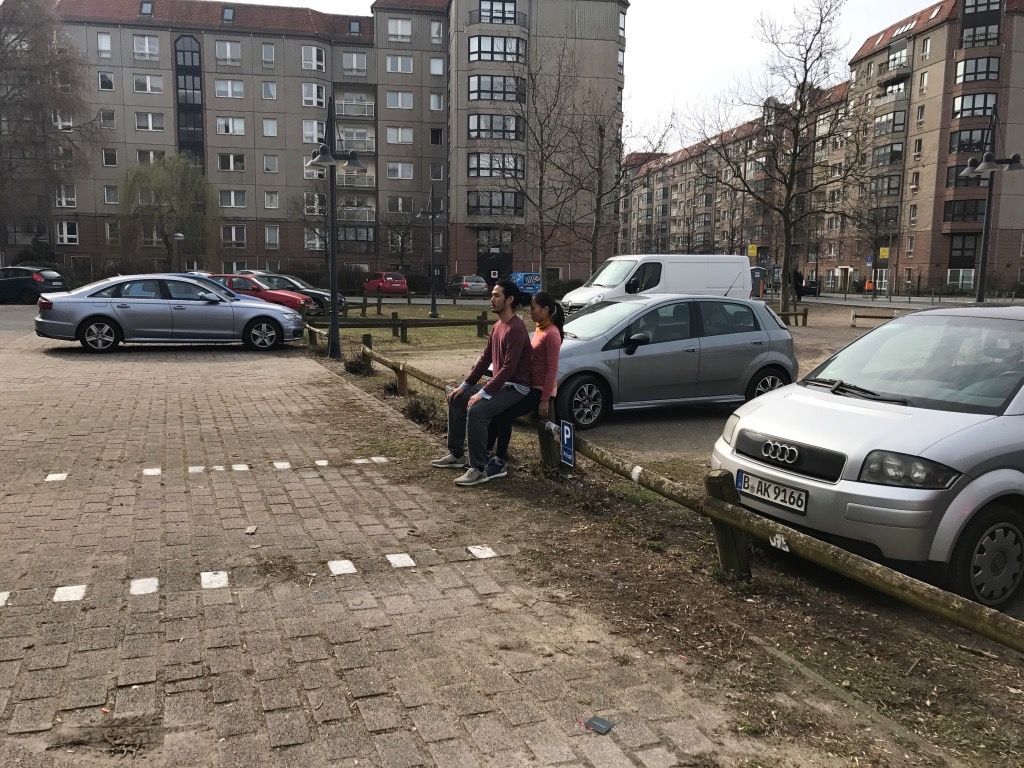
Dancers in the parking. Still image from the video. 246247596248914102516 … And then there were none (2017)
The part dedicated to the ambassador’s memoirs is also separated into different scenes that alternate: on the one hand, the chronological images of the creation of the panel’s replica filmed in Bangkok, and on the other hand a dance performance taking place in the parking lot of Berlin in the former site of Hitler’s bunker. The performers’ gestures embody the memoirs and give the text a visual texture. The couple, a man and a woman, move very slowly and express through their body language the tensions and contradictions at stake in the ambassador’s account of history. The first scene shows the man sitting on the knees of the woman, although he is taller and stronger than her. She seems fragile yet resistant and she then follows him like his own shadow. They seldom look at each other yet one can feel that an invisible and strong connection unify them. We do not know who or what they represent: the individual and history; aspirations and reality; Germany and Thailand, the ambassador and his wife or the ambassador and Hitler? The narrator/ ambassador relates his arrival in Berlin in 1938 with his family, and confesses he felt at ease there since he had lived in the city from 1911 to 1917 and had already many friends within the Nazi party. He is impressed by the German economy and achievements and admires the country. When he describes his first meeting with Hitler, the two dancers look at each other for the first time. “The moment I entered, I caught sight of a man in Nazi uniform... at that moment I immediately knew that he was the leader.” From that moment, the camera focuses on the dancers’ feet and follows the woman who begins to move backwards, away from the man. While the editing process is very simple and flat, with no special effects, flashback or additional images’ insertion, the tensions and questioning arise from these kinds of plans and subtle movements that unfold gently, just like historical events inevitably progress and develop.
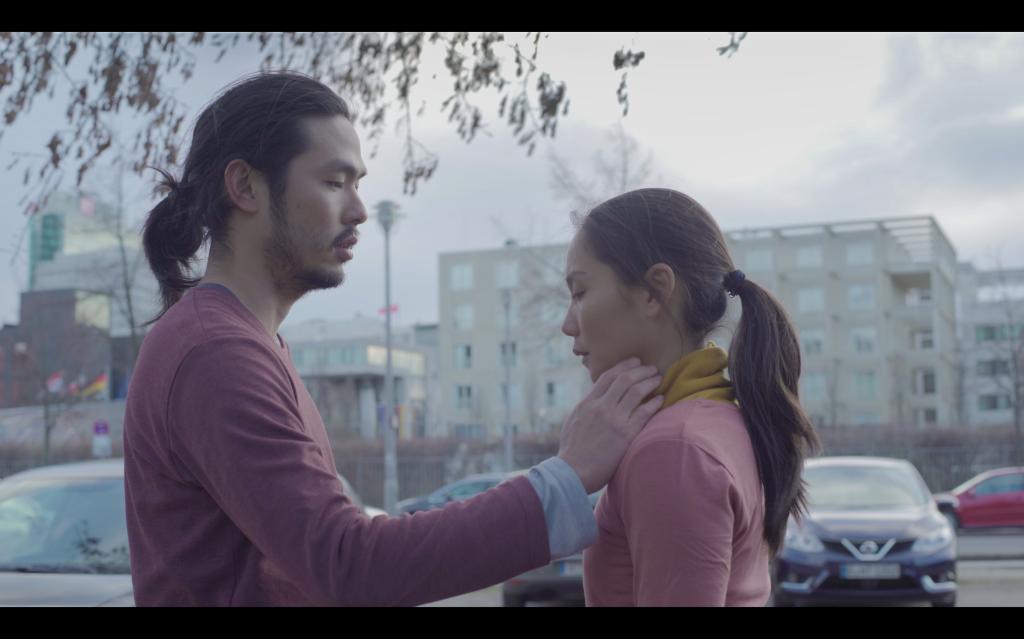
Dancers. Still image from the video. 246247596248914102516 … And then there were none (2017)
At no point there is anger or violence in the video. The voice of the artist, like the one of the ambassador’s narrator, is very warm, serene and soft. Rungjang also collaborated with a musician who created a very discreet and sometimes monotonous soundtrack, with single notes that can prolong for a long time. This very personal, human perspective contrasts with the history that is being told, its violence and its collective impact. “Berlin was once full of joy, but at that moment it was full of dead bodies, blood, smoke and gunpowder.” The ambassador seems to discover war’s horrors only when he begins to suffer and watches his daughter die. As a viewer, it is difficult not to react, since he supported this regime and this war, yet Rungjang never judges him. On the contrary, he chooses to highlight his human and fragile dimension. For the last part of his memoirs, the performance takes place inside a tiny flat that used to be part of Hitler’s chancellery. It echoes the Russian detention camp where the ambassador spent 225 days at the end of the war, and where he said people were treated like animals. Most of the time, the dancers are alone in the room before they find some recomfort in each other. The ambassador expresses his guilt and his tone becomes almost moralizing: “people in this world, let’s unite and establish permanent peace.” There is a form of fatality in the video, and an attempt to find peace, or at least reconciliation. For the artist, it is a way to emphasize how personal stories can suddenly collide with grand narratives, often involuntarily, yet there is again a tension between this conception of powerless individuals caught in the chaotic turmoil of history, and individuals who are seeking to take back control over this same history, for instance through their struggle for democracy.
Hence, 246247596248914102516 … And then there were none unfolds as a complex dialogue between all those layers of narrative and various modes of expression which respond to each other and weave multiple threads. This interplay of correspondences is in fact already announced by the enigmatic title of the installation which works as a riddle that viewers need to decipher. It refers to Thai numerology and in particular to the design of the Democracy Monument, conceived according to its principles. For instance, the height of the four wings is 24 meters because the 1932 revolution took place a 24 June, and the middle part is 3-meter high because 3 represents the month of June in the Thai calendar. Rungjang plays with these references in his own title and the first figures can be thus read as follow: 24th June of the Buddhist year 2475, which is 1932. The second part of the installation’s title, “And then there were none” refers to the first title of Agatha Christie’s novel Ten Little Indians, which was first published under the title Ten Little Niggers. For the artist, this is a way to connect his narratives to the vast enterprise of colonization that transformed the world and which consequences are still palpable today, notably in Southeast Asia.
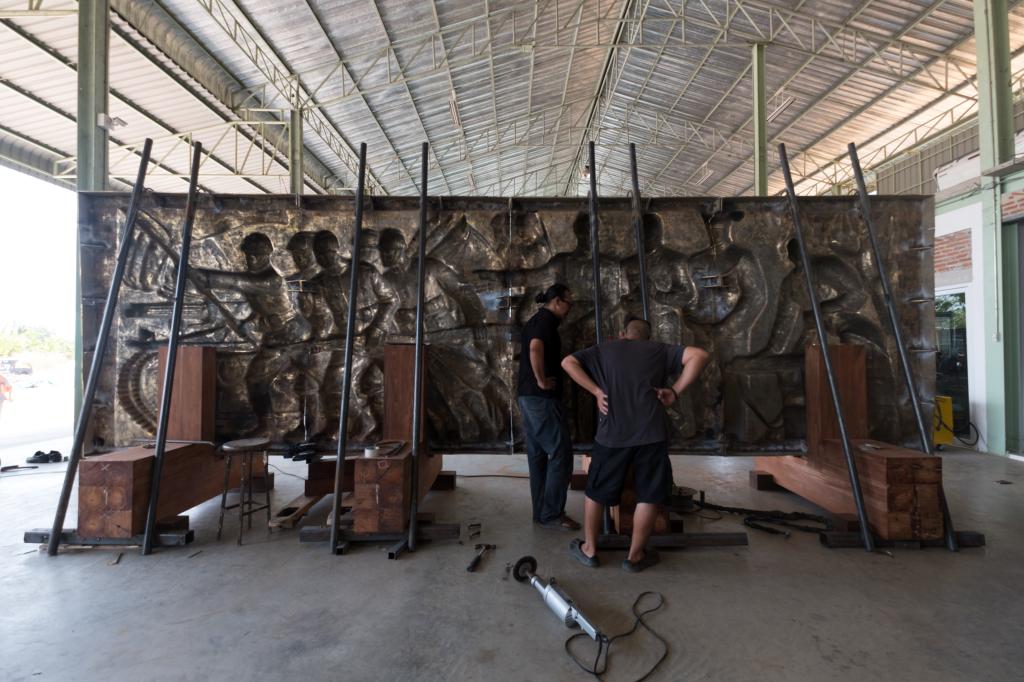
Back of the sculpture. 246247596248914102516 … And then there were none (2017)
Conclusion
With his research practice, Rungjang proposes a critical view of Thai recent history that blends personal and collective memories, connects originally some distinct events, distorts the effects of time and unfolds in a non-linear way through various means of expression. While the artist highlights some historical ruptures such as the 1932 revolution and World War II, he also traces back some continuity between these events and the present time. However, the artist does not display any evidence of his historical interpretation and does not seek to convince anyone of its value. The installation works as a mere artistic proposal yet this poetical perspective, whilst different from the views of a historian, allows us to renew the historiographical approach and to open up the field of history.
Despite the structured narratives that clearly develop through the voice-over, and the artist’s short explanations of Thailand’s key movements and actors during these events, the knowledge generated by the installation and by the artist’s research is purposely open-ended and fragmented, leaving a large part to the viewer’s active participation. There are many hidden layers and isolated pieces that need to be put back together although there is no unique reading of the work: everybody can reflect on his or her own experience of history from very subjective points. Some parts are in fact very moving and beyond the political stance of the installation it can be approached from a strictly human viewpoint, almost like a contemporary myth in which human beings struggle to face the course of history. In the very end of the video, the artist’s voice is asking “how do I quantify my life and the lives of others to the expanses of time? A second, a minute, a month; a year; (…) millions of years?” He remembers his mother and her perfume… and these small details seem to make us human in spite of all. “And then there were none” refers thus also to the human condition, when nothing is left except our part of humanity.
[1] The article is based on an artist’s interview from Jan. 19, 2018 in Hong Kong, e-mail conversations during Sept. 2020 and a phone interview on Sept. 14, 2020.
[2] Rungjang’s father was actually repatriated to Thailand where he died several months later from his internal injuries.
[3] « Inside Hitler’s Reich Chancellery 720p » on the History Channel. https://www.dailymotion.com/video/x3cfjry (Accessed Sept. 28, 2020).
[4] Chotpradit Thanavi, “A Dark Spot on a Royal Space: The Art of the People’s Party and the Politics of Thai (Art) History,” Southeast of Now, Vol.1 No.1 (March 2017):135.
[5] The David, Thai Art: Currencies of the Contemporary (Cambridge: The MIT Press, 2017), 25-26.
[6] Chambers Paul and Waitoolkiat Napisa, “Thailand’s Thwarted Democratization,” Asian Affairs: An American Review, 47, 2020: 156.
[7] Wong Ka, Visions of a Nation: Public Monuments in Twentieth-Century Thailand (Bangkok: White Lotus, 2006).
[8] Bangkok Post, 25 June 2017. https://www.bangkokpost.com/thailand/special-reports/1275251/what-has-happened-to-khana-ratsadons-architectural-heritage-)
[9] Chotpradit Thanavi, “A Dark Spot on a Royal Space: The Art of the People’s Party and the Politics of Thai (Art) History,” Southeast of Now, Vol.1 No.1 (March 2017):141.
[10] Chotpradit Thanavi, “A Dark Spot on a Royal Space: The Art of the People’s Party and the Politics of Thai (Art) History,” Southeast of Now, Vol.1 No.1 (March 2017):133.
[11] On this movement, see in particular Buchanan James, “Translating Thailand’s protests: An analysis of Red Shirt rhetoric,” ASEAS – Austrian Journal of South-East Asian Studies, 6(1), (2013):60-80.
[12] Chambers Paul and Waitoolkiat Napisa, “Thailand’s Thwarted Democratization,” Asian Affairs: An American Review, 47, 2020: 150.
[13] The issue of the 1973 events is in fact directly addressed by the other part of Rungjang’s installation exhibited in Athens in which the artist explores the lives of 5 Thai young people who lived through the 1973 protests.
[14] Thailand has been one of the countries where books have been the most banned. Publishers do not wish to publish anything related to politics, and this is probably why, according to the artist, the book was published as a fiction.
[15] More on his death see for example Kruger Rayne, The Devil’s Discus (Cassel, 1964).
[16] Chambers Paul and Waitoolkiat Napisa, “Thailand’s Thwarted Democratization,” Asian Affairs: An American Review, 47, 2020: 157.
[17] Article 112 of the Thai Criminal Code “criminalizes any comments or behaviour that is determined by the state to insult the Thai king, the heir-apparent or the regent (if there is one). Violators can be imprisoned for up to 15 years for each violation.” Chambers Paul and Waitoolkiat Napisa, “Thailand’s Thwarted Democratization,” Asian Affairs: An American Review, 47 (2020): 164.
[18] The Facebook page « Royal Marketplace » was officially shut down by the government in August 2020. See https://www.bangkokpost.com/tech/1974111/facebook-blocks-group-of-1m-critical-of-monarchy-amid-govt-pressure



